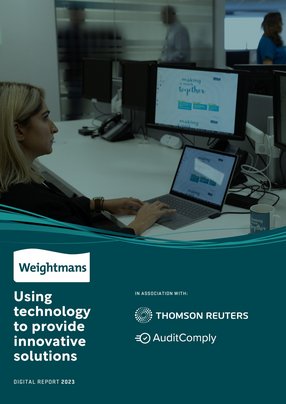Weightmans: using technology to provide innovative solutions
An award-winning top 40 UK law firm, Weightmans has more than 1,400 people working from offices in Birmingham, Cardiff, Glasgow, Leeds, Leicester, Liverpool, London, Manchester and Newcastle.
Stuart Whittle, Chief Technology and Innovation Officer at Weightmans – where he began his legal career almost 30 years ago – is particularly aware of how innovative technology can be utilised to gain insights and enable clients to reach their true potential.
A qualified solicitor and board member of the firm since 2010, Whittle’s current role renders him accountable for Weightmans’ information systems department, data services department, and its business change and knowledge management department, along with its formative product and innovation department.
“What makes us different is our people,” he explains. “Our clients say we're an easy firm to do business with. Every law firm says this, but there really is a focus on delivering the best results for clients.
“We recognise the fact that we're a service industry; it's not like it was 30 years ago. Our job is to fundamentally make clients' problems go away and, ideally, make them look good in the process.
“Having been a lawyer, it's pretty demanding and can be quite an all-consuming job at times. So it's important that people get something from it.”
The firm has been named a leading UK employer by the Top Employers Institute for 15 years in a row, with the firm scoring particularly highly in the most recent edition on business strategy, organisational change, onboarding, performance, engagement, values, ethics and integrity.
“Particularly when I think back to 30 years ago, one of our strengths is having built up increasing areas of specialism that enable us to meet the needs of clients,” Whittle says. “We've got employment specialists who really understand the health industry. We've got employment specialists who really understand unionised environments. And we regard ourselves as an organisation that can provide a full legal service to all of our clients.
“Ultimately, we want to be a top 30 law firm,” he adds. “Clients are at the heart of everything we do, and we aspire to be technology-driven, data-led, and innovative. And that's where the product and innovation department came from.”
Product and innovation department
As Whittle explains, Weightmans’ product and innovation team was born out of a desire to combine the firm’s legal expertise with emerging technology, delivering real benefits for businesses and allowing them to reach their potential.
“Many years ago, a consultant who worked in legal IT said to me that in law firms, if it isn't somebody's job, it doesn't get done,” he says. “So, three or four years ago, we created a very small innovation team with an even smaller budget just to see what we could do and get off the ground.”
A number of tools have since been developed, from a lawyer-led, outsourced HR department service to a scalable product that assists universities who are having to deal with students claiming compensation off the back of lecturer strikes. Then, around six months ago, Weightmans’ product and innovation department was launched, with an aim to systematise the firm’s approach to developing products and services.
“We've already got 60 potential ideas that have gone through a vision stage,” Whittle says. “We've narrowed those down to 30 at the first cut, and we need to narrow them down again.”
One such tool is an automated service which helps organisations calculate their casual workers’ holiday pay.
“There was a recent Supreme Court judgement that confirmed how employers are supposed to calculate holiday pay for casual workers,” he explains. “It completely affects any organisation which has seasonal workers, whether that is schools who employ term time people or retailers who employ people over Christmas.”
As a result, Weightmans built a holiday pay product allowing clients to push as much of their case load as they want to the firm, who will handle the cases and communication using their holiday pay tools.
“Off the back of that, we've also built a relatively straightforward fixed fee approach to dealing with any historic problems in terms of any claims from employees and former employees looking to get their holiday back-pay back. We can also look at what needs to be done going forward, in terms of standard employment contracts, staff handbooks, those kinds of things, so our clients aren’t perpetuating the problem.
“That's really what the product and innovation department role is,” Whittle adds. “And I don't know of any law firm that is doing it in quite the way we do it”
Importance of data and a single source of truth
The firm has a dedicated data services department of nearly 20 people, with two dedicated data scientists. A significant part of what enables Weightmans to innovate is its data warehouse.
Launched initially for a particular product, the data warehouse has evolved in the following years, now taking feeds from Weightmans’ finance system, HR System, CRM system and case management system to collect data about individual matters.
“In a defendant personal injury claims, for example, we might capture how much we think the claim might settle for, then what it actually settles for and the date it was settled,” comments Whittle. “We've got a CRM system, we take feeds from that. We've got an HR system that we take feeds from and that allows us to have a single source of the truth both internally for how we run the firm and externally for providing data and insights from that data to clients.
“Historically, one of the issues we faced was, depending on what system you asked, you'd get a slightly different answer to the same question, and then you'd spend the next three days working out why and which was the truth. The data warehouse was originally designed to solve that problem.”
When dealing with hundreds of reports, a single source of truth is key, Whittle explains. “You are essentially looking at the same data through different dimensions, but the total adds up to the same.
“Fifteen years ago, that wasn't always true. You could look at revenue by office, for example, and then add all of that up, then look at revenue by department and add all of that up, and you might get a different answer. That’s where our data warehouse has been and continues to be hugely powerful.”
Another innovation Weightmans has developed is its extranet service, which, combined with the firm’s case management system, allows Weightmans to provide information to external clients in a secure and innovative way.
“We might have a real-estate client where we're doing a large number of leases, or a big corporation where we do a lot of employment work,” starts Whittle.
“We can give the client access to each individual matter online, securely, where they can drill down right into the very matter, see the management information (MI) about that matter, and even see the linked documents. We can also create high-level management dashboards, so that our clients can have an overview of what's going on in their matters and can visualise that data, whenever they want to.”
Data, machine learning and predictive analytics
Data is a potent tool for businesses in the modern world. Powered by anonymised information from tens of thousands of personal injury matters, Weightmans is utilising the power of machine learning (ML) to assist case handlers at the start of a claim.
“Typically, what lawyers will do is hedge their bets,” Whittle explains. “So you'll put a higher figure just to cover your back so you don't have to go over that figure. As the claim matures and you get expert reports, documents and witness statements, you start to get a much better idea of what the claims are ultimately going to be settling for.
“What we've done with our predictive analytics tool is create models for different types of claims, such as motor claims, casualty claims or large loss claims. It’ll look at what data you do have for that matter and say, ‘typically, matters that have those sorts of features will settle somewhere between X and Y’.
“It's not giving the case handlers the answers, but it's giving them something to work with. It's giving them some confidence. And, then, what you're asking the case handlers to do is to use their skill and judgement to say, ‘actually, my experience is this case is a bit more involved than the average, so it's probably going to be closer to Y than X’.”
Another example of how data visualisation can be used to provide useful insights is when the company was dealing with thousands of holiday pay claims against a client, which is one of the UK’s biggest employers.
“A couple of years ago, there were some issues with holiday pay. The client had thousands of holiday pay claims,” explains Whittle. “There wasn't any argument in the law,” he says, “the law just changed and we had to deal with it. As part of dealing with the claims, we captured metadata about each of the claims, and we then played it back to the client through a dashboard that enabled the client to visualise the data. One of the dashboards that we developed showed where in the country these claims were coming from.
“What we could see was that, in the Midlands, there was a disproportionately large number of claims that had turned into tribunal claims and that cost the client more money. If it wasn’t for the data visualisation, we would never have seen it because there were too many claims for any individual to have noticed this pattern.
“We had a look at those files and it turned out there was a particularly activist trade union rep who was trying to force the pace. And so we took action and engaged with the trade union rep to say, ‘if you give us a chance, you don't need to take these to a tribunal, we will settle them but you need to understand that we are dealing with a large volume of claims so settling them will take a little bit of time’.
“We were able to then show the client that, over a period of time, that big blob of tribunal claims became a smaller blob because we'd taken action as a result of the data.”
Reaching potential through partnerships
As with many organisations, Weightmans has a number of partnerships that help both the firm and its suppliers reach their potential.
“I had an experience as a lawyer where one of my clients was more difficult to deal with than the other side,” says Whittle. “It was quite a hostile relationship, and one of the things I remember thinking at the time is, ‘this client isn't getting the best out of me’. When I came into our IT department, I saw that we had similar sort of relationships with some of our core suppliers.
“I wanted to change that around because we would go into meetings and nobody was having a good time. You didn't need to be a big reader of body language just to read the hostility in the room. I wanted to change that around. And I recognised that that's a two-way thing.”
One of Weightmans’ biggest suppliers is Thomson Reuters, which supplies the firm’s practice management, case management and document management systems and a significant amount of legal knowledge through its Westlaw and PLC services.
“To have a very hostile, negative relationship with an organisation that is so important to our business seemed to me to be counterintuitive,” Whittle comments. “We've done all sorts of things with Thomson Reuters. We've done some design sprints, some brainstorming. We've done a piece for them at Legal Geek, which is a legal IT conference where we looked at the metadata they had on judgements. They'd never given anyone access to that before.”
“Where it fits in with our business, we will also work with them to help develop solutions. Software suppliers always need clients who are willing to work with them, and that's what I mean by partner. While all of that is a cost to me and my organisation, the benefit to me is the building of the relationships within the supplier.”
Another of Weightmans’ partners is AuditComply, which the firm not only uses for its internal audits, but also for solutions to assist its clients.
“How do you demonstrate to your ISO 27,001 auditor, your ISO 5,000 and 14,001 auditor that you are doing your internal audits?” says Whittle. “Previously, we had spreadsheets and Word documents, but now we've got it all in this system.
“Clients have the same issue. It's not just 27,001, it's health and safety audits, or anything where clients have particular standards they need to meet and then demonstrate they're meeting those standards. If you think about our work as a personal injury firm, we see corporate and public sector bodies who are sued due to an employee being injured.
“One of the things that can be quite challenging for the organisation is they say, ‘we did nothing wrong’. And we say that's fine ,show us the evidence that you did all of the things that you were supposed or you could be reasonably expected to have done.”
“That doesn't always exist, and then it's very difficult to defend the claim for the client. Sometimes accidents do just happen. You put all the precautions in place and sometimes accidents do just happen, and it's nobody's fault. So AuditComply really is a potential solution for clients to help capture all of that information in one place.”
The product lifecycle
In turbulent economic times, the focus at Weightmans is to continue to look after its people and its clients.
“Our board is focused on navigating the firm through a macroeconomic environment, which even economists tell us has no precedent in history,” Whittle says. “And that's quite challenging.
“A lot of my time is spent focused on bedding in our new product innovation team, generating revenue from the products we're developing.”
With the product and innovation department still in its early stages, a challenge will be establishing the product lifecycle as the firm moves forward.
“One of the things we don't know yet – and this is because we've only been doing it for six months – is what does our product lifecycle look like?” he says. “How long does it take us to get these things to market? How long do they last in the market? And when do we decide that the market for this particular product is dying, because it's done what it needed to do?
“A lot of these things, such as the new holiday pay product, will have a finite lifespan,” Whittle concludes. “But the focus now is making sure we have a pipeline so we know that, when one project starts to tail off, we've got the next thing coming through that will replace it.”






